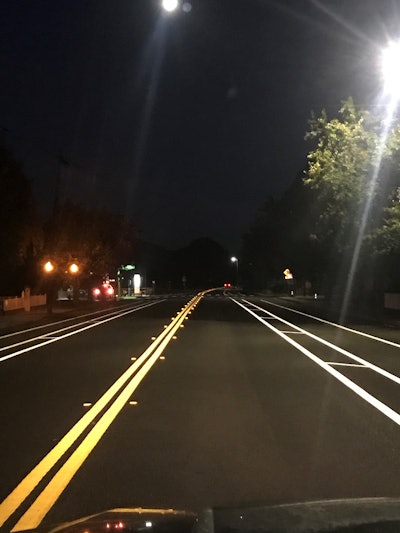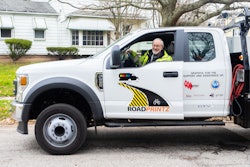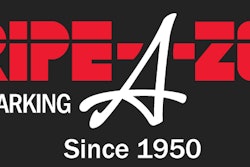
There is obviously a lot of excitement and even hype about the future of vehicle technologies to automate the task of driving. And when you combine the vehicle automation progress with the potential of connectivity and the shared economy, there are significant signs of an innovation revolution in the transportation sector.
As the excitement and hype builds, so does pressure to get engaged and be part of the revolution. One of the questions that many road agencies think about is, “What can we do to prepare our highways for this innovation—to help accelerate the benefits while not sacrificing the needs of human drivers in the mixed vehicle fleet era?”
While the question has been hard to answer with complete certainty, the best answer so far is also one of the simplest. We’ve known since at least 2013 that the automotive industry has desired higher standards in terms of uniform applications and maintenance of pavement markings.
In 2013, Michael J. Robinson of General Motors testified before the House Committee on Transportation and Infrastructure Subcommittee on Highway and Transit saying that, “One of the key highway needs is to provide – at a minimum – clearly marked lanes and shoulders.” In 2015, Elon Musk complained about low contrast markings in a tweet.
In 2016, Volvo’s North American CEO Lex Kerssemakers lost his cool as the automaker’s semi-autonomous prototype sporadically refused to drive itself during a press event at the Los Angeles Auto Show. “It can’t find the lane markings!” Kerssemakers griped to Mayor Eric Garcetti, who was at the wheel. “You need to paint the bloody roads here!”
Audi has now joined the group of unhappy automotive companies. In May 2018 Audi announced that their much-anticipated Level 3 technology (Traffic Jam Pilot on the 2019 Audi A8) will not be available in the United States because of several factors including legal and infrastructural. On the infrastructure side, Audi points to road markings, signage, and road configurations that can vary significantly from state to state and region to region – rendering a single solution impractical if not impossible.
In January 2018, the Federal Highway Administration (FHWA) published 10 questions in the Federal Register with the intent to develop a better understanding of what was needed from the infrastructure side to support automated driving systems. In May 2018, the FHWA summarized the top themes from the RFI, including, “Greater uniformity and quality in road markings and traffic control devices would enable automation. Having greater consistency in road markings and traffic control devices and an improved state of good repair benefits all road users, including ADS.”
This FHWA finding prompted action within the National Committee on Uniform Traffic Control Devices (NCUTCD), whose purpose is to assist the FHWA in the development of standards, guides and warrants for traffic control devices and practices used to regulate, warn and guide traffic on streets and highways.
The Marking Technical Committee of the NCUTCD developed a task force to consider the FHWA ADS RFI findings related to markings. That task force reviewed the available research and developed draft pavement marking criteria to engage stakeholders (e.g., automotive industry, highway industry, and policy makers).
The draft criteria are driven by the needs of the cameras and the software that are used to detect pavement markings. The draft criteria include suggestions to improve uniformity such as dotted lane line extensions along exit ramps and chevron style markings in gore areas (neither of which are consistently practiced throughout the US). They also include criteria to help the cameras (and humans) detect markings in otherwise challenging conditions such as worn markings, wet conditions, glare, etc. (the suggestions include standardizing the width of edge lines at 6-inches and standardizing the skip length of a broken line to 15 feet).
Some agencies are already conforming to these recommendations but national uniformity is lacking. For instance, Michigan and Florida Departments of Transportation (DOTs) have been using 6-inch wide markings for years. Agencies such as Michigan and Florida adopted 6-inch wide markings as a way to evolve their infrastructure to accommodate older drivers. California adopted 6-inch wide markings in 2018 as a way to accommodate automated vehicle technologies (many of the companies pursing automated vehicles are based in California).
The point is that the highway infrastructure has evolved before (for the last 20 years there has been a push to accommodate older drivers) and will continue to evolve. The next evolution might be the transition from the human driver to the machine driver. But in the meantime, for the foreseeable future, there will be a mix of human drivers and machine drivers on the road. The challenge will be to find areas where the highway infrastructure can evolve to assist the adoption of automated vehicle technologies while accommodating the needs of human drivers.
In October 2018, the U.S. DOT released their highly anticipated document, “Preparing for the Future of Transportation: Automated Vehicles 3.0 (AV3.0).” This document introduces guiding principles and describes the U.S. DOT’s strategy to address existing barriers to safety innovation and progress (https://www.transportation.gov/av/3). One of the most noteworthy items described in this document (as it relates to pavement markings) is that the FHWA will pursue an update to the 2009 Manual on Uniform Traffic Control Devices (MUTCD), taking into consideration the needs of automated vehicle technologies, “The U.S. DOT recognizes that the quality and uniformity of road markings … support safe and efficient driving by both human drivers and automated vehicles (pg. 11).”
The biggest challenge for the FHWA as they develop a new MUTCD is what to include that will demonstrate their intent to address the needs of automated vehicle technologies. For road markings, there is likely to be subtle changes from current practices. In other words, there will not be a significantly new requirement such as embedded microchips in road markings. However, there may be changes such as 6-inch wide edge lines, and possibly adding minimum required pavement marking retroreflectivity levels (which has been a Congressional mandate since 1993 that FHWA is still trying to fully implement). Changes likes these have been proven in multiple studies to be good for both the human driver and the machine driver.
Greg Driskell, ATSSA Board of Directors member and president of Professional Pavement Products, Inc., said when it comes to AVs and roadway infrastructure, it’s important to talk about the “hurdles” and what is most needed today and tomorrow.
“The most important infrastructure element on our roadway system for automated vehicles (AVs) and for Advanced Driver Assist Systems (ADAS), is pavement markings,” Driskell said. “There’s a significant and almost complete reliance on pavement markings for the automated vehicle technologies of today. A lot of people think AVs mean the car drives down the road and you’re facing the other direction, working on your computer, but we have partial AVs on the road right now. Honda, Cadillacs, Chevrolets, they all have these ADAS systems and they all depend heavily on being able to see that pavement marking.”
“A lot of people don’t think we will need signs, traffic signals, or pavement markings in the future but if you talk to the people who are doing the automated vehicle work, they insist that pavement markings are a vital infrastructure asset now and, in the future,” Driskell said. “They have all of these sensors, all this technology, but pavement markings give them confirmation that their sensors are providing good information. Ultimately, the auto side is telling me they’re always going to want pavement markings on the road. That is a positive sign for pavement marking contractors.”
Paul Carlson is chief technology officer, Road Infrastructure, Inc., [email protected].










![Lee Boy Facility 2025 17 Use[16]](https://img.forconstructionpros.com/mindful/acbm/workspaces/default/uploads/2025/09/leeboy-facility-2025-17-use16.AbONDzEzbV.jpg?ar=16%3A9&auto=format%2Ccompress&fit=crop&h=135&q=70&w=240)








